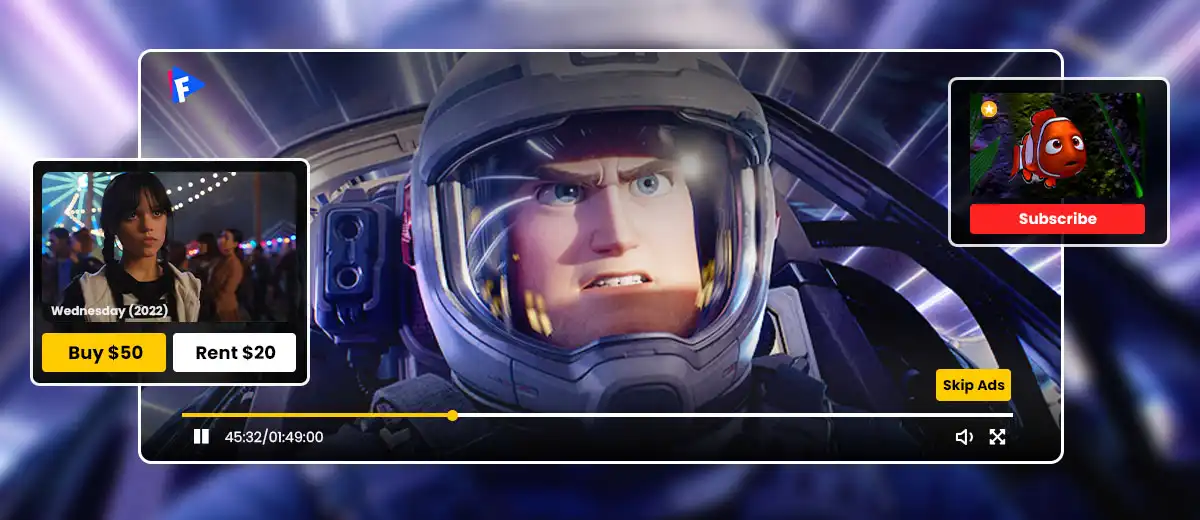Video streaming has become an essential aspect of our entertainment culture. With the rise of OTT streaming platforms, content creators and businesses are constantly exploring different ways to monetize their video content. Three popular models that have emerged in this space are AVOD (Advertising-Based Video on Demand), SVOD (Subscription Video on Demand), and TVOD (Transactional Video on Demand). Each model presents unique opportunities and challenges for content creators, and understanding their differences is crucial for anyone looking to make informed decisions about video monetization. In this article, we looks about the three monetization models differences AVOD vs SVOD vs TVOD.
What is Avod?
AVOD stands for Advertising-Based Video on Demand, is a video streaming model that offers content to viewers for free, supported by advertisements. Platforms employing AVOD generate revenue by displaying targeted advertisements before, during, or after the video content. This model is commonly used by platforms like YouTube and Hulu, where users can access a wide range of content without paying a subscription fee.
One of the key advantages of AVOD is its accessibility. By offering free content, AVOD platforms attract a larger audience, which can be leveraged to generate significant advertising revenue. Furthermore, AVOD allows content creators to reach a broad audience and build brand awareness. However, it’s important to note that the revenue generated from AVOD can be highly dependent on factors such as the number of views, ad engagement rates, and the overall advertising market.
Features of AVOD
- Free Access: AVOD allows users to watch videos without any upfront payment.
- Wide Range of Content: AVOD platforms offer a diverse collection of videos, including user-generated content, TV shows, movies, and more.
- Advertisements: As AVOD relies on advertisements for revenue, users may encounter ads while watching videos.
- Targeted Advertising: AVOD platforms use targeted ads based on user preferences and demographics to provide relevant content and maximize ad revenue.
Benefits of AVOD
- Cost-Free Viewing: AVOD is an excellent option for budget-conscious viewers who prefer not to pay for content.
- Accessible to All: AVOD platforms make video content available to a broader audience, without the need for subscriptions.
- Vast Content Library: AVOD platforms offer an extensive range of videos, catering to diverse interests and tastes.
- Personalized Ads: The targeted advertising on AVOD platforms ensures that users receive advertisements relevant to their interests, potentially enhancing their overall viewing experience.
What is SVOD?
SVOD stands for Subscription Video on Demand, operates on a subscription-based model, where users pay a recurring fee to access a library of exclusive content. Popular examples of SVOD platforms include Netflix, Amazon Prime Video, and Disney+. With SVOD, users enjoy an ad-free viewing experience and have the flexibility to consume content at their own pace.
For content creators, SVOD offers a more stable revenue stream compared to AVOD. Subscriptions provide a predictable income, allowing creators to invest in high-quality productions and attract top-tier talent. SVOD platforms also offer valuable user data and analytics, enabling content creators to better understand their audience and tailor their content accordingly. However, competition within the SVOD space is fierce, and platforms must continuously deliver compelling and exclusive content to retain subscribers.
Features of SVOD
- Subscription-based: SVOD requires users to pay a subscription fee to access the content.
- Extensive Content Library: SVOD platforms offer a wide variety of movies, TV shows, documentaries, and original productions.
- Ad-Free Experience: Unlike AVOD, SVOD platforms do not display ads during video playback.
- Multiple Device Compatibility: SVOD services are accessible across various devices, including smartphones, tablets, smart TVs, and gaming consoles.
Benefits of SVOD
- Ad-Free Viewing: SVOD platforms provide an uninterrupted viewing experience without any advertisements.
- Exclusive Content: Many SVOD services produce original content that is only available on their platform, enticing users with unique offerings.
- Convenience and Flexibility: Subscribers can watch content anytime and anywhere, as long as they have an internet connection and compatible devices.
- Personalized Recommendations: SVOD platforms employ algorithms to suggest content based on users’ viewing history, enhancing their content discovery process.
Read About This: 5 Simple Steps to Create Your Own OTT Platform
What is TVOD?
TVOD stands for Transactional Video on Demand, allows users to access specific video content on a pay-per-view or rental basis. Platforms like iTunes and Google Play Movies employ this model, where users can rent or purchase movies, TV shows, or other digital content for a specific period.
TVOD provides content creators with an additional revenue stream, particularly for new releases or premium content that may not be available on SVOD platforms. Users pay for the specific content they want to watch, and content creators earn revenue based on the number of transactions. However, TVOD faces challenges in terms of competition from illegal streaming sites and the need to constantly release fresh and engaging content to attract viewers.
Features of TVOD
- Pay-per-View: Users pay a fee for each individual video they want to watch.
- Recent Releases: TVOD platforms often provide access to newly released movies and TV episodes.
- Rental or Purchase Options: Users can choose to rent a video for a limited duration or purchase it for permanent access.
- Library Access: TVOD platforms maintain a library of available videos, allowing users to select their desired content.
Benefits of TVOD
- Latest Releases: TVOD platforms offer quick access to recently released movies and TV episodes.
- Flexible Viewing: Users have the freedom to choose when and how they watch content, without the constraints of a subscription.
- Pay-per-Use: TVOD allows users to pay only for the content they want to watch, offering a cost-effective solution for occasional viewers.
- No Subscription Commitments: Unlike SVOD, TVOD does not require users to commit to a recurring payment plan, providing more flexibility.
Read Also this : SVOD vs AVOD: Best revenue model in 2023
Avod vs Svod vs Tvod : A comparison
| Feature | AVOD | SVOD | TVOD |
| Revenue Model | Advertisements | Subscription Fees | Pay-per-view/ Rental |
| Content Access | Free, with ads | Subscription-based | Pay-per-view |
| Content Library | Limited selection | Extensive library | Limited selection |
| Advertisements | Contains ads | No ads | No ads |
| Cost | Free (with ads) | Subscription fees | Pay-per-view/ Rental |
| Example | YouTube, Crackle | Netflix, Hulu | iTunes, Amazon Instant |
AVOD vs SVOD vs TVOD: How to Choose the right model?
When it comes to choosing the right model among AVOD vs SVOD vs TVOD for your content distribution, here are five points to consider:
Content type and audience:
Evaluate the nature of your content and the preferences of your target audience.
AVOD➡️ is suitable for reaching a broad audience with free access but may require content creators to sacrifice some control and potentially disrupt the viewing experience with ads.
SVOD➡️ provides a more personalized and ad-free experience, appealing to subscribers who are willing to pay for exclusive content.
TVOD➡️ is ideal for content creators who want to monetize individual titles or rentals and cater to users who prefer selective content consumption.
Revenue goals:
Consider your revenue goals and monetization strategy.
AVOD➡️ relies on advertising revenue, so if you have a large viewership potential and advertisers interested in your target audience, it can be a viable option.
SVOD➡️ generates recurring revenue through subscription fees, allowing for predictable income but requiring a compelling content library to attract and retain subscribers.
TVOD➡️ can be suitable if you have valuable or exclusive content that users are willing to pay for on a per-view or per-title basis.
Long-term commitment:
Assess your commitment level and resources.
SVOD➡️ requires ongoing content production and maintenance of a subscription-based platform.
AVOD➡️ may demand continuous efforts to attract advertisers and sustain a substantial user base.
TVOD➡️ can offer more flexibility as it does not require a long-term commitment, but you need to ensure a steady stream of new and engaging content to drive transactions.
User experience and brand image:
Consider the user experience you want to provide and the brand image you want to cultivate.
AVOD➡️ may have more intrusive ads that can affect user satisfaction, while SVOD offers an ad-free experience that can enhance viewer engagement.
TVOD➡️ allows users to choose specific titles without interruptions, but they may need to pay for each viewing. Align your choice with the desired perception of your brand and the expectations of your target audience.
Market analysis:
Conduct thorough market research and analysis. Study the competitive landscape, user preferences, and market trends. Analyze the success of existing platforms and services in your niche using different models.
Identify gaps, opportunities, and potential demand for your content. Consider the market dynamics, such as the saturation of subscription-based services or the demand for specific genres or content formats, to make an informed decision.
Choosing the right model depends on your preferences and needs. AVOD is suitable if you prefer free access but can tolerate advertisements. SVOD is ideal for those who consume a lot of content and want unlimited access without ads. TVOD is a good option if you only want to watch specific movies or shows and are comfortable paying for individual content on a per-use basis.
Conclusion
Are you prepared for AVOD? Or perhaps you’re leaning towards SVOD or TVOD.Whichever option you decide on, rest assured, you’ll make the perfect choice.We trust that this guide has provided you with valuable insights and assisted you in selecting the ideal VOD model for your enterprise.And if you’re still in search of a platform that empowers you to swiftly establish an SVOD business, you’re in luck! We’ve got just what you need to hit the ground running. Feel free to reach out if you need further assistance or information.
Frequently Asked Questions
1. what is the difference between avod vs svod vs tvod?
AVOD is ad-supported free streaming, SVOD is subscription-based streaming, and TVOD is pay-per-view or rental streaming.
2. Can I watch the latest movies on SVOD platforms?
SVOD platforms may have a mix of older and newer content, including original productions, but the availability of the latest movies depends on licensing agreements.
3. Are TVOD rentals time-limited?
Yes, TVOD rentals typically have a specific duration during which the content can be viewed.
4. Can I skip ads on AVOD platforms?
Some AVOD platforms offer the option to skip ads after a certain duration, while others require users to watch the entire ad.
5. Do SVOD platforms offer family plans?
Yes, many SVOD platforms offer family plans that allow multiple users to access the service simultaneously.



Leave a Reply